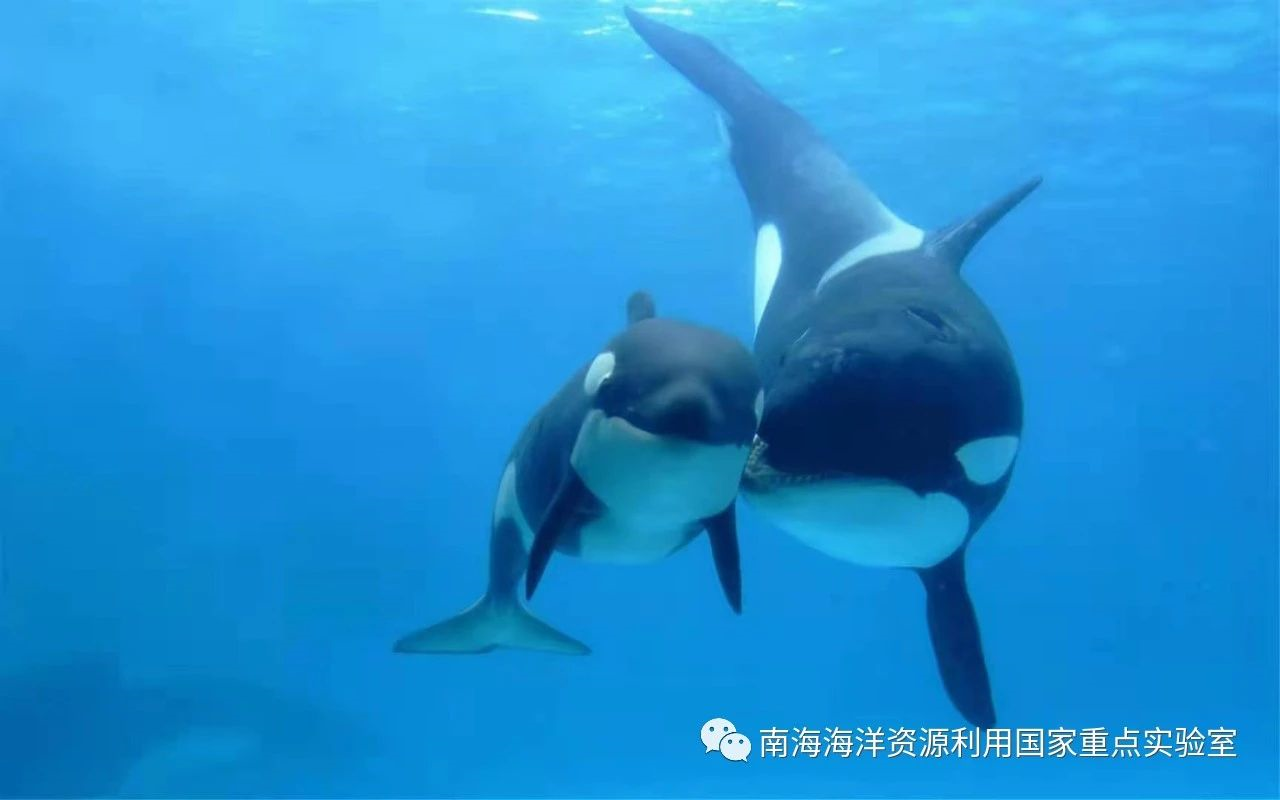海洋哺乳动物是哺乳类中适于海栖环境的特殊类群,通常被人们称作为海兽。是海洋中胎生哺乳、肺呼吸、恒体温、流线型且前肢特化为鳍状的脊椎动物。海洋哺乳动物主要包括鲸目 (Cetacea)、鳍脚目(Pinnipedia)和海牛目(Sirenia)。我国现有各种海兽39种。都是从陆上返回海洋的,属于次水生生物。属游泳生物。
Marine mammals are a special group adapting to the marine environment and are often referred to as marine animals. They are viviparous, lung-breathing and thermoregulatory, and they are streamlined vertebrates in the ocean with specialized flipper-like forelimbs. Marine mammals mainly include Cetacea, pinnipedia and sirenia. There are 39 species of sea animals in China, and all of them return to the sea from the land and belong to the sub-aquatic organisms. And they are swimming organisms.

海洋哺乳动物简介
Introduction to Marine Mammals
体呈流线型、前肢特化为鳍状、体温恒定、胎生哺乳和进行肺呼吸的海洋脊椎动物。又称海兽。它们都是由陆上返回海洋的,属于次水生生物。一般包括鲸目、鳍脚目、海牛目的所有动物,以及食肉目的海獭和北极熊。鲸目动物(如鲸、海豚)和海牛目动物(如儒艮、海牛)终身栖息在海里,为全水生生物;而鳍脚目动物(如海豹、海狮)需要到岸上进行交配、生殖和休息,食肉目的海獭和北极熊仅在海中捕食和交配,为半水生生物。生活在河流和湖泊中的白暨豚、江豚、贝加尔环斑海豹等,因其发展历史同海洋相关,也被列为海洋哺乳动物。
Marine mammals, also called marine animals, are streamlined vertebrates in the ocean with specialized flipper-like forelimbs. They are viviparous, lung-breathing and thermoregulatory. All of them return to the sea from the land and belong to the sub-aquatic organisms. Marine mammals mainly include all animals of cetacea, pinnipedia and sirenia as well as the carnivorous sea otters and polar bears. Cetaceans (e.g. whales, dolphins) and sirenians (e.g. dugongs, manatees) live in the sea for life and are fully aquatic, while pinnipedians (e.g. seals, sea lions) need to go to the shore for mating, reproduction and resting, and carnivorous sea otters and polar bears which are semi-aquatic only hunt and mate in the sea. The white dolphin, porpoise and Baikal ringed seal which live in rivers and lakes are also classified as marine mammals because their development history is related to the sea.
海洋哺乳动物是海洋中的一特殊类群 , 它们既有哺乳类的许多共同特点 , 如胎生 、哺乳 、体温恒定 、用肺呼吸等 , 又经漫长的自然选择和演化过程 , 形成了其独特的形态结构 、 生理机能和生态习性以适应海洋生活 , 如体呈纺锤形以适应游泳 、体被一层厚厚的脂肪或毛以利保持体温 、 前肢鳍状 (水獭除外) 等 。
Marine mammals are a special group in the ocean. They have many common characteristics of mammals, such as viviparity, lactation, constant body temperature, and breathing through lung, etc. They have also undergone a long process of natural selection and evolution to form their unique morphological structures, physiological functions and ecological habits to adapt to marine life, such as a spindle-shaped body to adapt to swimming, a thick layer of fat or hair to maintain a constant body temperature, and flipper-like forelimbs (except otters).
分类 (包括鲸目、海牛目和鳍脚目)
Classification (including cetacea, sirenia and pinnipedia)
鲸目
Cetacea
全水栖,形似鱼;长可达30多米;皮肤裸露,仅吻部有少许刚毛,皮下脂肪肥厚;前肢鳍状,后肢退化,尾肢为游泳器官;眼小,视力差,觅食和避敌主要靠回声定位;头顶有鼻孔1~2个;有肺2叶,营呼吸作用;无外耳壳,外听道细小,但感觉灵敏,且能感受超声波;胚胎时期都有齿,但须鲸类的齿在出生时变为须,齿鲸类终生有齿。分3个亚目,已知90余种。
Fully aquatic, fish-like; up to 30 meters long; skin exposed to the outside world, only a few setae on the muzzle, thick subcutaneous fat; flippered forelimbs, degenerated hindlimbs, tail limbs are swimming organs; small eyes, poor vision, feeding and avoiding enemies mainly by echolocation; 1 to 2 nostrils on the top of the head; 2 lobes of lungs to help respire; no external ear shell, external auditory canal is small but sensitive and can feel ultrasound; have teeth in embryonic period, but the teeth of mysticeti become baleen at birth, and toothed whales have teeth throughout their lives. There are three suborders with more than 90 known species.
海牛目
Sirenia
全水栖,纺锤形;皮厚,毛稀疏;颈短,有缢纹,颈椎互相分离;前肢鳍状,后肢缺失,仅保留腰带骨;无背鳍,尾鳍宽大扁平;臼齿咀嚼面平坦;胃多室,肠长,植食性,主食海藻;行动缓慢,好群居。分3科,其中大海牛科已于18世纪灭种,仍保存海牛科和儒艮科共4种。
Fully aquatic, fusiform; thick skin, sparse hair; short neck, neck and vertebra separate from each other; flippered forelimbs, hindlimbs missing, only the girdle bones remain; no dorsal fin, broad and flat caudal fin; flat molar chewing surface; multi-chambered stomach, long intestine, phytophagous, especially algae; slow moving, group living. There are three families, of which the family Steller’s Sea Cow was extinct in the 18th century, but four species of Manatee and Dugong are still preserved.
鳍脚目
Pinnipedia
半水栖,似陆兽;密被短毛;头圆,颈短;四肢呈鳍状,前肢保持平衡,后肢为主要游泳器官;趾间有蹼;鼻和耳孔均有活动瓣膜,潜水时都关闭;口大,周围有大量触毛,有不同型牙齿;听、视、嗅觉都灵敏,具水下声通讯和回声定位能力。
Semi-aquatic, resembling land animals; densely covered with short hairs; round head, short neck; flipper-like limbs, forelimbs for balance, hindlimbs as the main swimming organs; webbing between toes; nostrils and ear holes have movable valves which close while diving; large mouth, surrounded by a large number of tentacles, with different types of teeth; hearing, vision and smell are sensitive, with underwater acoustic communication and echolocation ability.
生物学特征
Biological Characteristics
哺乳动物在脊椎动物中最高等。
Mammals are the highest class among vertebrates.
1、体表被毛;
1. Body surface is covered with hair.
2、胎生,哺乳;
2. Viviparity, lactation
3、牙齿有门齿、犬齿和臼齿的分化。
3. Differentiation of incisors, canines and molars.
海洋哺乳动物除具有胎生、哺乳、体温恒定、用肺呼吸等陆上高等哺乳动物的特点外,还由于生活在海洋中,产生了一系列的水生特征。
In addition to the characteristics mentioned above of terrestrial higher mammals, marine mammals also have a series of aquatic characteristics due to living in the ocean.
体型
Body Size
海洋哺乳动物的体型都很大,远非陆生哺乳动物可以相比。蓝鲸为世界最大的动物,体长达33米、重达 190吨。即使体形最小的海獭,其成年雄性体长也达1.47米、重约45公斤;雌性长为1.39米、重约33公斤。
Marine mammals are very large and far from being comparable to terrestrial mammals. The blue whale is the largest animal in the world, reaching 33 meters in length and weighing 190 tons in weight. Even the smallest sea otter, the adult male is 1.47 meters long and weighs about 45 kg, and the adult female is 1.39 meters long and weighs about 33 kg.
海洋哺乳动物都是游泳生物。身体呈纺锤形或流线型。其中鳍脚目动物和海獭、北极熊是半水生生物,均具四肢,外形与陆上兽类相似;鲸类和海牛类是全水生生物,体形似鱼,但它们的尾鳍呈水平状,与鱼类的垂直状尾鳍是不同。
Marine mammals are all swimming creatures. The body is spindle-shaped or streamlined. Pinnipedians, sea otters and polar bears are semi-aquatic creatures with four limbs, similar in appearance to land animals; cetaceans and sirenians are fully aquatic creatures with fish-like bodies, but their caudal fins are horizontal, which is different from the vertical caudal fins of fish.
肺呼吸
Respiration through Lung
海洋哺乳动物是由陆上动物演化而来,依然保持着用肺呼吸的方式,每隔一段时间便浮出水面换气。它们不但善于游泳,还善于潜水,抹香鲸(Physetercatodon)可潜在水中长达1.5小时。
Marine mammals evolve from land-based animals and still use their lungs to breathe, surfacing so often to take a breath. They are not only good swimmers but also good divers, and the physetercatodon can stay submerged for up to 1.5 hours.
体温
Body Temperature
海洋哺乳动物分布很广,南、北两极尤多。为保持体温,防止体热过多的散失,它们都有很好的保护层:鲸类具有很厚的皮下脂肪,鳍脚类具有很好的毛皮。
Marine mammals are widely distributed, especially in the North and South Poles. To maintain their body temperature and prevent excessive heat loss, they have a good protective layer: cetaceans have thick subcutaneous fat, and pinnipedia species have thick fur.
繁殖生长
Reproduction and Growth
海洋哺乳动物繁殖较慢,多数一年一胎、一胎一仔,有的是三年一胎。哺乳期较长,半年至一年多。初生仔也较大,如抹香鲸出生时体长约4~4.5米,刚出生的海獭长约61厘米。幼兽跟随母兽的时间也较长,这些都是为了保证其后代的成活率。
Marine mammals are slow to reproduce, with most having one baby per year, and some having one baby per three years. Their lactation period is long, from half a year to more than a year. Newborns are also large, for example, sperm whales are about 4 to 4.5 meters long at birth, and newborn sea otters are about 61 centimeters long. Young animals also follow their mothers for a long period of time, which is to ensure the survival rate of their offspring.
 公众号
公众号